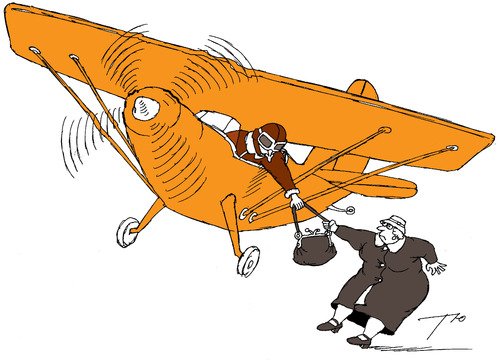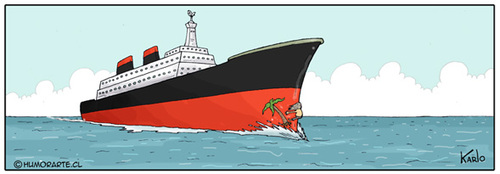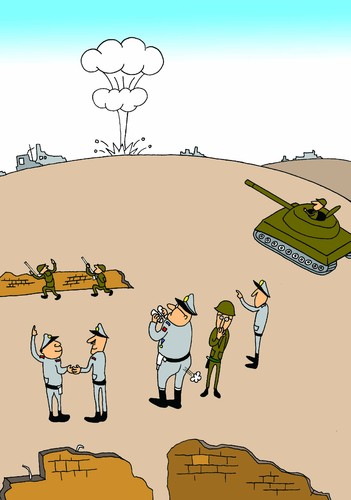Full-page newspaper cartoons were pretty common in the United States during the first half of the 20th century. Today they are mostly extinct, which is a pity because the size of the page allows for amazing and innovative art. Germany, on the other hand, never had a really strong tradition of newspaper comics. Luckily, some papers began to publish large-sized comics a few years ago. One of them is the German version of monthly newspaper Le Monde diplomatique. Fifty comics origally published in Le Monde diplomatique have now been anthologized in a beautiful book named “In 50 Comics um die Welt” (“Around the World in 50 Comics”).
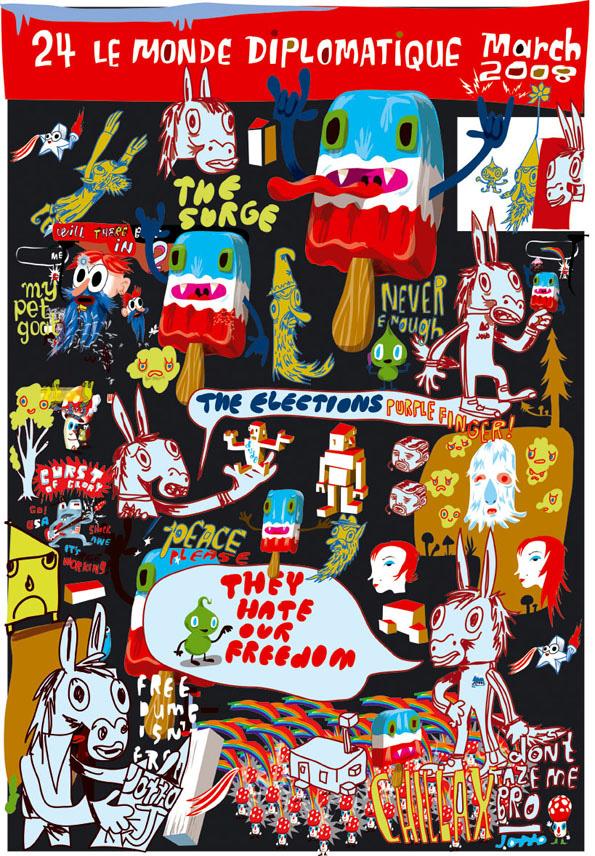 The title’s “Around the World” aspect not only refers to the newspaper’s title, it is also a hint towards the wide range of artists found in the book. Each comic page was designed by a different artist, about half of them from Germany, the oher half from all over the world. There are, for example, pages done by Berlin-based artist ATAK, Finnish designer Leena Kisonen and US illustrator J. Otto Seibold (left).
The title’s “Around the World” aspect not only refers to the newspaper’s title, it is also a hint towards the wide range of artists found in the book. Each comic page was designed by a different artist, about half of them from Germany, the oher half from all over the world. There are, for example, pages done by Berlin-based artist ATAK, Finnish designer Leena Kisonen and US illustrator J. Otto Seibold (left).
Artwork and subject matter of the comics are as diverse as the contributing artists. There’s some commentary on current events, as shown in the two examples given here (the awesome baisse bear below, by the way, is by German artist Lisa Röper). Other cartoons are moreof the storytelling kind or showa Dada-ish kind of humor. Jens Bonnke’s “Petit Alphabet Allemand”, for example, tells us that “G” is for “Gesichtswurst” and “O” for “Ou-Ha!”. As a whole the comics could be described as ‘somewhat artsy’ and very often the distinction between comic, cartoon and illustration is blurred.
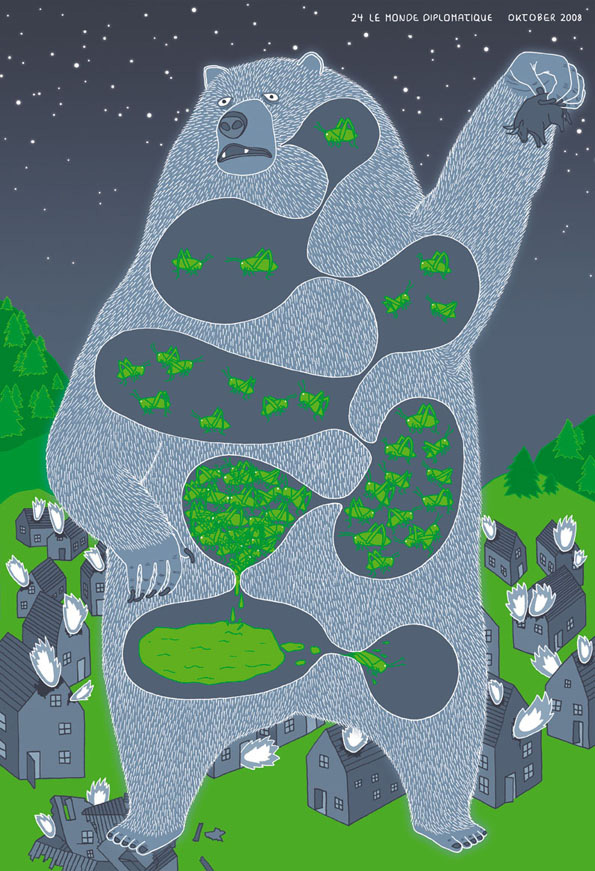 In most cases, the captions are in German although there are some comics without words and a few ones in English. While the verbal content is definitely worth exploring – take, for example, the sound bites included in the Seibold piece – the sheer visual impact of the pictures already makes the book worthwhile. The innovative visual design of these comics points out parallels to early precedents such as George Herriman’s Krazy Kat or Winsor McCay’s Little Nemo. Still, each one of them also shows the impact of avantgarde and underground comix. Being roughly the original size (34 x 23 cm), the cartoons are printed on heavy tan paper, which I am sure looks even better than in the original newspaper version.
In most cases, the captions are in German although there are some comics without words and a few ones in English. While the verbal content is definitely worth exploring – take, for example, the sound bites included in the Seibold piece – the sheer visual impact of the pictures already makes the book worthwhile. The innovative visual design of these comics points out parallels to early precedents such as George Herriman’s Krazy Kat or Winsor McCay’s Little Nemo. Still, each one of them also shows the impact of avantgarde and underground comix. Being roughly the original size (34 x 23 cm), the cartoons are printed on heavy tan paper, which I am sure looks even better than in the original newspaper version.
Maybe it’s just wishful thinking, but aren’t full-page / full-color cartoons a way to help both traditional newspapers looking for something that makes people buy the print edition and for cartoon artists looking for wider distribution? Well.. I hope that more newspapers adopt this feature and, until this happens, I recommend Le Monde diplomatique‘s anthology.
Bofinger, Karoline (ed.). In 50 Comics um die Welt. Berlin: Reprodukt, 2010. pp 64. 29 Euros.
Exhibition
June 4 to 26, 2010
Galerie Neurotitan
Haus Schwarzenberg
Rosenthaler Str. 39
13127 Berlin
Opening Hours:
Monday through Saturday 12 am to 8 pm, Sunday 2 pm to 7 pm
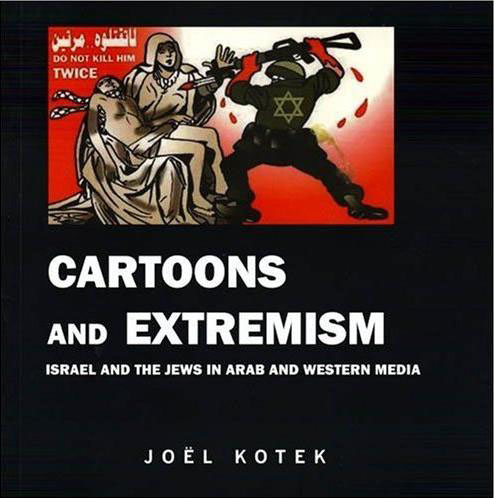 Joël Kotek’s book is based on the observation that there has been a relatively recent (~ 2000) change of quality and amount of cartoons on Israel in Arab media.
Joël Kotek’s book is based on the observation that there has been a relatively recent (~ 2000) change of quality and amount of cartoons on Israel in Arab media.
These cartoons are – as one would guess – aggressively anti-Israel. Moreover, they are blatantly racist, often using images based on century-old anti-Semitic myths, termed “antisemyths” by the author. Since we are living in visual times, these cartoons can be dangerously effective in forming public opinion. The book’s intention is to “deprive [these depictions] of all legitimacy” by exposing them as what they truly are: myths without any foundation in reality.
The first chapter of “Cartoons and Extremism” looks at anti-Semitic myths like infanticide, host desecration and blood libels and traces them back to the 12th and 13th century. Chapter Two deals with the particularities of cartoons in the Muslim world and tells about changes in the depiction of Israel after 1967. The main part of the book, chapter 3, shows recent cartoons using the ancient myths and imagery that hardly differs from anti-Semitic cartoons in Nazi newspaper “Der Stürmer”. The last two chapter then deal with similar imagery in both mainstream European newspapers and leftist anti-globalization platforms and show how Israel is being used as a scapegoat and metaphor for modernity.
The book offers several explanations for the abundance of anti-Semitic imagery. The most prominent one aims at the structural conditions of the Arab media.
Authoritarian structures, says Kotek, prevent many Arab cartoonists from criticizing their own country’s political parties and leaders. Instead, they cut out on the social criticism and humor and deliver heavy, serious and moralizing pieces about an acceptable enemy: Israel and the Jews. These are printed in the majority of the major dailies in the Arab world. Therefore, in the epilogue Kotek sets out to denounce that editorial practice and to “alert the cartoonists of the Arab-Muslim region to a certain sense of responsibility”. In order to do so, he includes twelve theses by the father of peace research, Johan Galtung, pointing out common dangers in reporting on conflict. Some of which, I had the impression don’t really apply to cartooning.
“Cartoons and Extremism” is an interesting book to read, and I fully support its project to sensitize people for anti-Semitic imagery and scapegoating of Israel. It has, however, a couple of flaws that are at times irritating.
First and foremost, its arguments are somewhat weakly supported. Using lengthy quotes from other authors Kotek claims that antisemyths are a symptom of crisis and that anti-Zionism has ” become a means of drowning a feeling of vague guilt on the part of the West”. But he does little to prove this. I understand that the evolution of stereotypical of images in a given culture is a continuous process but since Mr. Kotek claims that there are some crucial dates that marked a change I was sort of waiting for an explanation on how these events changed cartooning. At times, the author’s way of depicting Israel, was leaving out important aspects of the Middle East conflict. I am aware of the danger of ending up saying “Well, it’s their own fault too” when talking about hateful stereotypes. Still, I was a bit annoyed when Mr. Kotek claimed that the scapegoat Israel was really “a defenceless animal”.
The books greatest strength as well as its second big flaw is its use of images.
There are plenty of them, and their number effectively communicates the fact that we are dealing with widely shared stereotypes and not with single cases of tasteless cartoons. On the other hand, I think that Kotek has been overdoing it. There is, for example, simply no point in spending 15 pages in order to show that Brazilian cartoonist Carlos Latuff (a toonpool.com member, by the way) is an anti-Semite. Several pictures are obviously jpegs in awful resolution, some even appear twice in the book. Personally, I could have done without the graphic photos of dead babies, too. The problem with the overabundance of images also ties in with the lack of argument. Some of them have no connection whatsoever with the written text – there’s a whole chapter on the “Strange Case of Greece” that manages to avoid telling what’s so strange about Greece.
In retrospect the book turned out abit disappointing, mostly due to its argumentative weaknesses. Still, I think raising awareness in artists and readers is a very important thing to do and that is something “Cartoons and Extremism” actually can do.
Joël Kotek. Cartoons and Extremism: Israel and the Jews in Arab and Western Media. Edgware, Middlesex: Vallentine Mitchell (2009).
Mr. Kotek, how come so many cartoonists, including both Arabic artists and Western anti-Globalization folks, are insensitive towards connections between their works and what you call “Antisemyths”?
 Strangely enough they do not seems to understand ‘our’ point of view… They consider their work as strictly anti-Israeli and/or anti-zionist. How to explain this ? 1) complete ignorance: actually, they haven’t read my book) 2) hypocritical attitude (they know they produce harsh propaganda but refuse to admit it) 3) worst… they don’t understand our concern because they really share the Stürmer like demonic antisemitism. Personally, this is what I believe. I have no doubt about the fact that radical anti-Semitism is now growing in the Moslem world. My collection of Arab caricatures demonstrates this. The collective image of the Jews created by Arab cartoons lays the groundwork for a possibility of genocide. One can argue about whether these genocidal ideas are conscious or subconscious. My view is that they are still at the subconscious stage.
Strangely enough they do not seems to understand ‘our’ point of view… They consider their work as strictly anti-Israeli and/or anti-zionist. How to explain this ? 1) complete ignorance: actually, they haven’t read my book) 2) hypocritical attitude (they know they produce harsh propaganda but refuse to admit it) 3) worst… they don’t understand our concern because they really share the Stürmer like demonic antisemitism. Personally, this is what I believe. I have no doubt about the fact that radical anti-Semitism is now growing in the Moslem world. My collection of Arab caricatures demonstrates this. The collective image of the Jews created by Arab cartoons lays the groundwork for a possibility of genocide. One can argue about whether these genocidal ideas are conscious or subconscious. My view is that they are still at the subconscious stage.
What, in your opinion, is the connection between anti-Semitism and the common claim of cartoonists that they are merely “anti-Zionists”?
One cannot confuse between “anti-Semitism” and “anti-Zionism”. The argument and thus the graphic code are radically different. Even if I do not share this opinion, “anti-Zionism”, if not radical, is a legitimate opinion. You can be opposed to the idea of a Jewish state – even if it looks strange to me that any people can have a homeland (Kosovars, Palestinians, Kurds, etc.) but not the Jews.
The trouble is that what they believe are anti-Zionist cartoons are outright copies or plagiarisations of images from the Nazi press, foremost “Der Stürmer”. Paradox ally, it is at the very time when, after centuries of obscurantism, Europe discovered the virtue of tolerance, that the Arab-Muslim world united for blatantly expedient reasons to appropriate the stereotype that were hitherto unknown there.
I had the feeling that you were pretty vague about why and when exactly the number of anti-Semitic cartoons increased so greatly. Could you elaborate on that change?
The change came slowly after the 1967 war. Before 1967, the Israeli was just a “dhimmi” that could be very easily exterminated. They were then presented as little devil – the real evil and/or master being the American imperialism. After the 1967 defeat, everything changed since the dhimmi refuse to be exterminated. How could 300,000 million Arabs, one billion Muslims not be able to defeat a country as big as… Corsica ? Logically, the arrived to an phantasmal, but useful, explanation: the Jew as the personification of evil, the real master of the world.
Do you think an appeal towards artists’ and editor’s responsibilities like yours can be effective, when propaganda-style cartoons are a fixed feature of both Arabic newspapers and anti-Globalization websites? Do you know of any voices from within those circles demanding a more differentiated approach and a halt on anti-Semitic imagery?
As far as I know this happen only in Germany. Almost all national indymedia sites publish Carlos Lattuff’s anti-Semitic cartoons. The only one that had the courage to ban them was the German indymedia website.
I suppose one should organize conferences explaining the difference between a political and a racist caricature. What is a (political) caricature ? A criticism and/or an exaggeration of a reality. What is an anti-Semitic cartoon ? A pure invention ! The Israelis do not kill Palestinian children for ritual purposes ! Israelis and Jews are not ugly or evil by nature !
The idea would be to persuade the cartoonists and their bosses that there is a limit not to trespass : racism. In brief, to persuade them to adopt a code of good conduct. Actually this is, more a less, what the French cartoonist Plantu (Le Monde) is trying to organize under the auspices of the UN.
What would you say is the right way to deal with cartoons using anti-Semitic imagery on an international platform for cartoons like toonpool.com?
They should be banned. The limit of the freedom of expression is racism… As their Nazi counterparts, those cartoons are genocidal. They are “ruse de guerre”, “ruse de massacre”, to use the expression of Anthony Julius. Anti-Semitism (and/or racism) is not a opinion but a crime.
Thanks for your time!
]]>Du zeichnest eigentlich Cartoons und Comic-Strips. Warum jetzt plötzlich ein ganzer Comic-Roman?
So plötzlich war das nicht. Ich habe vier Jahre an dem Buch gearbeitet von der ersten Idee bis zum Druck, natürlich mit Unterbrechungen. Reine Zeichenzeit für Storyboard, Skizzen und Tuschezeichnung waren so ungefähr drei Monate. Ich mag das Kurze und Prägnante beim Cartoon, aber es reizt mich genauso, längere, komplexere Geschichten zu erzählen. Und dafür ist der Comic ein perfektes Medium. Man kann alles gleichzeitig sein: Drehbuchautor, Regisseur, Szenograf, Maske und Kostümbildner – nur einen Produzenten, also Verleger, braucht man noch.
Was haben Deine Cartoons und der Comic gemeinsam? Gibt es Parallelen?
Der Humor ist schon gleich. Dabei ist der Comic etwas leiser als die Cartoons. Um wieder den Vergleich zum Film zu ziehen: es ist eine klassische Komödie mit komischen Charakteren, Verwicklungen und einem Happy End.
Wie bist du auf die Geschichte gekommen? Warum der Berliner Fernsehturm?
Ich lebe in Berlin und mag den Fernsehturm einfach sehr gern. Er ist mein Hauptorientierungspunkt in der Stadt. Jedes Mal, wenn ich bei einem Besuch mit dem Aufzug nach oben fahre, frage ich mich, was um mich herum im Schaft passiert. Das sind mehrere tausend Kubikmeter umschlossener Raum, zu dem kein Besucher Zutritt hat. Dieser Raum ist also sehr geheim, obwohl der Turm an sich so präsent in der Stadt steht. Dazu kommt, dass ich mir als Kind oft vorgestellt habe, an der Decke zu laufen.
Die Handlung ist eng mit der Architektur verknüpft und die schwarzweißen Zeichnungen sind sehr klar und einfach. Ist da die Architektin in Dir durchgekommen?
Ja, tatsächlich hatte ich beim Zeichnen das Gefühl, dass ich jetzt endlich weiß, warum ich Architektur studiert habe. Das war also nicht umsonst. Die Panels sind sehr gerade aufgebaut, es gibt keine schrägen, überzogenen Perspektiven, dafür aber einige Gebäudeschnitte, damit der Leser die räumliche Verdrehung nachvollziehen kann. Das sieht dann so aus, dass die Menschen, die im Turm an der Wand laufen, sich auf den Bildern senkrecht an der rechten Bildkante bewegen.
Mit dieser Raumdrehung spielst Du auch mit den Möglichkeiten des Comics. Ich hatte zum Beispiel beim Lesen das Bedürfnis, das Buch zu drehen. Aber der Text in den Sprechblasen ist in normaler Leserichtung angeordnet. Soll man das Buch gar nicht drehen?
Es darf natürlich jeder das Buch lesen, wie er will. Ich habe das so angeordnet, weil ich und der normale Leser ja mit der normalen Gravitation leben. Wir blicken in die andere Welt, die um 90 oder 180 Grad gekippt ist, nur hinein. Ein wenig verwirren kann und darf das natürlich.
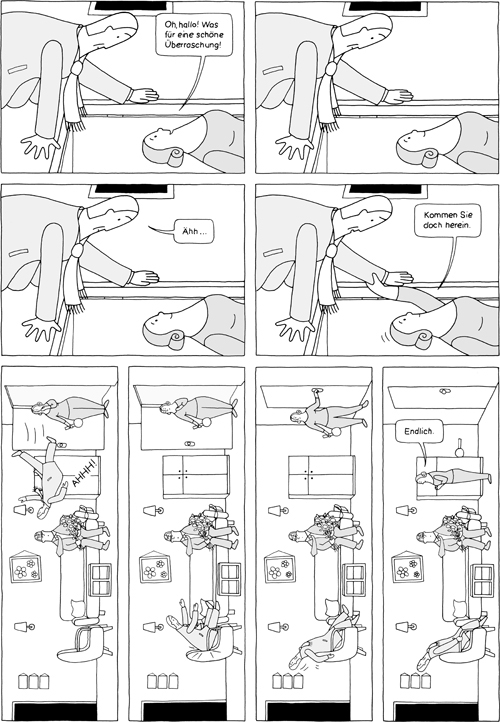
Das waren jetzt eher formale Fragen. Kommen wir zum Inhalt. Was sind das für Menschen, die dort im Fernsehturm leben? Haben die übernatürliche Kräfte?
Nein. Das mag sich jetzt seltsam anhören, da sie ja an der Wand laufen können und das kennt man nur von Superhelden wie Spiderman. Aber es sind ganz normale Leute. Die weibliche Hauptperson Gabi zum Beispiel ist eine etwas pummelige Frau, die verzweifelt auf der Suche nach einem Mann ist. Sie belegt Kurse wie „Ohne Schokolade leben“. Und irgendwann hat sie mal einen Kurs gemacht, in dem sie eben gelernt hat, ohne Schwerkraft zu leben. Der Fahrstuhlführer Franz ist auch ein ganz normaler Typ, der einfach auf der Suche nach persönlichem Freiraum ist. Am Ende schafft er es, die Erkenntnisse, die er im Turm gesammelt hat, auf sein Leben zu übertragen und seine Probleme zu lösen. Damit ist er kein Superheld, sondern eher ein Alltagsheld.
Wie ist denn eigentlich das Leben ohne Schwerkraft?
Genauso wie mit ohne Schokolade, nur eben mit ohne Schwerkraft, wie die Gabi aus dem Buch sagen würde. Das bringt natürlich ein paar Schwierigkeiten mit sich: Die Möbel müssen an die Wand gedübelt werden und auch das Trinken in dieser Position will gelernt sein.
Wie viel Autobiografisches steckt in der Geschichte?
In jeder Geschichte steckt ein wenig von einem selbst. Aber ich gehöre nicht zu den Comic-Autoren, die ihr eigenes Leben aufzeichnen. Die Fiktion hat den großen Vorteil, Geschichten verallgemeinern und sie gleichzeitig verdichten und auf den Punkt bringen zu können. Ich bin zum Beispiel keine Fahrstuhlführerin und habe mich auch nicht von Schokolade emanzipiert. Am ehesten kenne ich die Suche nach dem eigenen Freiraum – und das ist sicher eine Lebensfrage für viele. Ich habe, zumindest für die nächste Zeit, eine Lösung für dieses Problem gefunden.
Und die wäre?
Comics zeichnen.
Auch wenn Du keine Comics über Dein Leben zeichnest, vielleicht erzählst Du etwas von Dir. Wie sieht es zum Beispiel an Deiner Decke aus?
Da hängt ein verchromter, italienischer Leuchter aus den 60er Jahren mit passenden Energiesparlampen. Die waren in der Anschaffung teurer als der Leuchter. Ansonsten müsste die Decke dringend mal wieder gestrichen werden – übrigens nicht wegen irgendwelcher Fußspuren.
Und wenn Dir die Deck auf den Kopf fällt?
Glücklicherweise bietet Berlin viel unterschiedliche Zerstreuung für diesen Fall an. Gestern zum Beispiel war ich bei einer sehr kurzweiligen Lesebühne und morgen gehe ich zum Zahnarzt.
Die letzte Frage: Gibt es eine Fortsetzung von „Ein Mann geht an die Decke“?
Wenn, dann mache ich es wie George Lucas bei Krieg der Sterne: Dann gibt es die Geschichte davor, die erzählt, warum die Leute im Fernsehturm so leben, wie sie leben.
Vanessa Oxygen
…………………………………………………………….
EIN MANN GEHT AN DIE DECKE von Katharina Greve
Verlag: Die Biblyothek, Leipzig
ISBN13: 978-398104806-3
48 Seiten, Hardcover, 19 x 26 cm, 1-farbig, 1. Auflage: 10/2009, 14,- EUR
Mit einem Vorwort von Günter M. Ziegler, Professor für Diskrete Geometrie, TU Berlin und Leiter des Medienbüros der Deutschen Mathematiker-Vereinigung
www.ein-mann-geht-an-die-decke.de
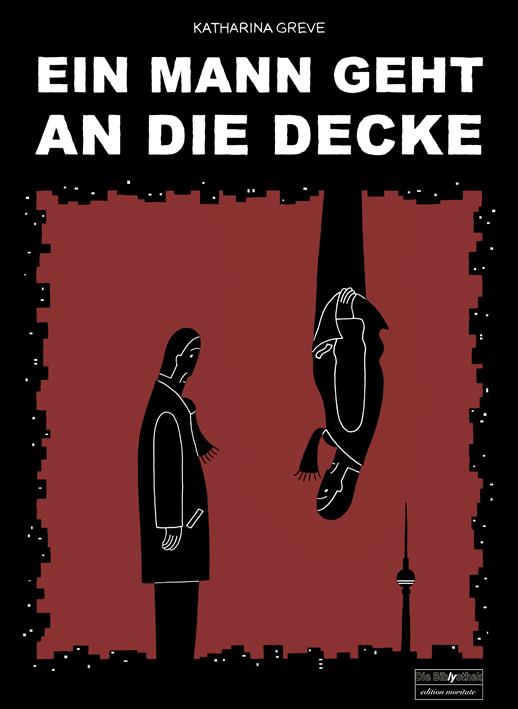
Anyway, he other event I was talking about is the Islamic Festival of Sacrifice, or عيد الأضحى, or Kurban Bayramı which is taking place between November 27 and December 1st. Even though I live in a neighborhood with a large percentage of Muslims, I would have missed the holiday if it wasn’t for toonpool.com. Just like Christmas, Kurban Bayramı is used to comment on various aspects of society. There are cartoons about swine flu, burkas, and… other topics. One picture by Saadet Yalcin made me wonder how vegan Muslims deal with the situation. I would be glad if anyone could tell me. On the opposite side of the spectrum there’s this one cartoon, that is outright scary if you think about it a bit longer.
Introducing…
 This week, I would like to introduce Gud from Rome, who has contributed two interesting series of pictures so far. The first is named “Crazy Hair” (1,2,3,4) and deals with.. hair. The second (1,2,3,4,5,6) doesn’t have an official name but is best described as a kind of “crossover homage”. It combines characters from different comic books in a single panel – all drawn in Gud’s slightly scribbly lines. Some people might complain that these aren’t really cartoons because there is no joke, but there is something in panels like “Corto Maltese and Krazy Kat” that strikes a note in me.
This week, I would like to introduce Gud from Rome, who has contributed two interesting series of pictures so far. The first is named “Crazy Hair” (1,2,3,4) and deals with.. hair. The second (1,2,3,4,5,6) doesn’t have an official name but is best described as a kind of “crossover homage”. It combines characters from different comic books in a single panel – all drawn in Gud’s slightly scribbly lines. Some people might complain that these aren’t really cartoons because there is no joke, but there is something in panels like “Corto Maltese and Krazy Kat” that strikes a note in me.
Cartoons of Interest
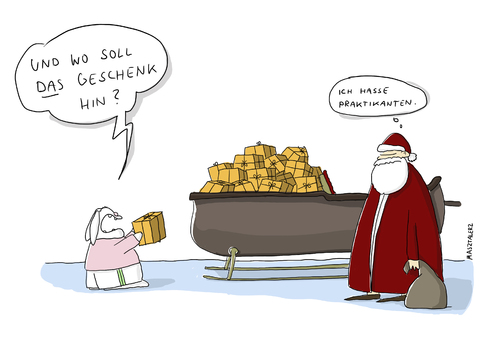 This week’s favorite is “Praktikant” by Comicpiero. [B: "… and, where do I put this present?" S: "God, I hate interns."] Cartoons that combine Santa and the Easter Bunny might not be new but, as a former intern, I know those questions. And I did ask them – and probably was annoying as hell.
This week’s favorite is “Praktikant” by Comicpiero. [B: "… and, where do I put this present?" S: "God, I hate interns."] Cartoons that combine Santa and the Easter Bunny might not be new but, as a former intern, I know those questions. And I did ask them – and probably was annoying as hell.
There were two close contestants this week, both of them caricatures: There is this great Manmohan Singh by Junior Lopes and Kim Yong Il hiding a loaf of bread.
Paul Hellmich
]]>Last week, as every week, there were some new mysterious cartoons. I think this one by Portos is a good example for the I-don’t-understand-a-word category. The I-could-understand-it-if-I-knew-anything-about-your-culture category is being adequately represented by new member Mohamed Alafia, whom I will introduce below. Then, there are some cartoons that I think I should be understanding but I don’t: one in German, one in English, and two without any dialogue. There’s one that uses clear symbolism but makes your brain hurt if you try to think about it. And there are at least two that havecrossed the line to surrealism (one, two)
Introducing…
 Mohamed Alafia’s cartoons are sporadically mysterious. Sometimes this is due to my ignorance of Moroccan topics (here & here) and a little research does help. At other times it’s due to my ignorance of Moroccan topics but even Wikipedia is clueless. Who is that Ponky guy? One cartoon, however, remains mysterious even though the captions are pretty clear. Anyway, Alafia’s style is interesting to look at – especially when he does these scribbly outlines in what might be ink, adds another layer of paler and broader ink scribbles and then puts in blotches of color on his computer (e.g. here). I’ve never quite seen anything like this before.
Mohamed Alafia’s cartoons are sporadically mysterious. Sometimes this is due to my ignorance of Moroccan topics (here & here) and a little research does help. At other times it’s due to my ignorance of Moroccan topics but even Wikipedia is clueless. Who is that Ponky guy? One cartoon, however, remains mysterious even though the captions are pretty clear. Anyway, Alafia’s style is interesting to look at – especially when he does these scribbly outlines in what might be ink, adds another layer of paler and broader ink scribbles and then puts in blotches of color on his computer (e.g. here). I’ve never quite seen anything like this before.
 German artist Schwoe has uploaded only four cartoons so far (1, 2, 3, 4). And, since I am German too I understand all of them. The reason I am mentioning them here is because they are funny, well-drawn, and make my neck hurt in a peculiar way because of the perspective Schwoe employs. Seriously. It’s like looking at German newscaster Klaus Kleber [I found this cartoon when looking for the photo… toonpool.com has once again made page one of the search results. yay!]
German artist Schwoe has uploaded only four cartoons so far (1, 2, 3, 4). And, since I am German too I understand all of them. The reason I am mentioning them here is because they are funny, well-drawn, and make my neck hurt in a peculiar way because of the perspective Schwoe employs. Seriously. It’s like looking at German newscaster Klaus Kleber [I found this cartoon when looking for the photo… toonpool.com has once again made page one of the search results. yay!]
Cartoons of Interest
I think my favorite cartoon this week is “Daylight Robbery” by Russian artist Sergej Tunin. I love those old timey pilots in their leather caps and goggles and it’s fun to imagine the sound of the plane.
Paul Hellmich
]]>Of the more accessible cartoons, I liked the contrast between this one by Dragan from Spain and this one by German artist GB. Funny thing is, that both views of post-reunification Germany are true. There is a kind of normality – there’s a whole Generation of kids going to college or starting in their first jobs who know the GDR only from stories. At the same time, there are vast differences between western and eastern Germany, two cultural spheres, if you will, let alone economic differences. And, sometimes, in my oversimplifying moments of Berlin-born-college-boy-grandeur, I think that GB is right in describing both cultural spheres as being united by their petty bourgeois foundations.
An interesting thing happens when artists link the Berlin wall to the Israeli West Bank barrier, as in this piece by Paolo Lombardi referencing “Test the Best” on Berlin’s East Side Gallery. The strong appeal of a wall as a symbol of injustice apparently overrides all difficulties that arise when you compare the historical background of the two walls. On the other hand, comparing them anyway might lead to interesting new insights as happened accidentally in the comments to this 2008 piece by Ben Heine.
Introducing…
 Continuing with the West Bank theme, I would like to introduce new artist Ramzy Taweel, who actually lives in Palestine. He drew these two cartoons about his thoughts on the issue (note the one-legged background guy on the beach). Apart from fitting this week’s topic, Ramzy totally qualifies for this column by his art – a clear message, a clean, professional style and effective use of colors. My favorite among his non-political cartoons is about Henson-folk and flu. Apparently, I missed out on the passing of Big Bird some time last year.
Continuing with the West Bank theme, I would like to introduce new artist Ramzy Taweel, who actually lives in Palestine. He drew these two cartoons about his thoughts on the issue (note the one-legged background guy on the beach). Apart from fitting this week’s topic, Ramzy totally qualifies for this column by his art – a clear message, a clean, professional style and effective use of colors. My favorite among his non-political cartoons is about Henson-folk and flu. Apparently, I missed out on the passing of Big Bird some time last year.
 I further would like to introduce Mallorca-based German artist Nicki Wambolt. I don’t want to write about great and innovative use of colors again (I feel that I always do), but then again, Wambolt’s use of color is great and innovative in a way different from the other artists’ individual great and innovative ways. So, yeah. Be sure to check out the dog-eared audience, the dangers of play-doh, the plate of chilies and the glass-house guy.
I further would like to introduce Mallorca-based German artist Nicki Wambolt. I don’t want to write about great and innovative use of colors again (I feel that I always do), but then again, Wambolt’s use of color is great and innovative in a way different from the other artists’ individual great and innovative ways. So, yeah. Be sure to check out the dog-eared audience, the dangers of play-doh, the plate of chilies and the glass-house guy.
Cartoons of Interest
This week’s favorite is plain and simple. “Naufrago” (“Shipwrecked”) by Karlo from Chile. Things like these probably happen all the time.
Paul Hellmich
]]>While “the grand debates of our times” may not be decided this way, I think it’s a fun thing to do. Until now, there are two problems that limit the full potential of the feature. First, there are lots of unrelated postings, probably more due to the uploading mechanism than to people doing this on purpose. Second, the number of cons sent in is … limited at best. The reason here obviously lies in the nature of the question posted. There just aren’t enough vocal supporters of Burkas on toonpool.com to make this a real debate. All in all, I think both problems will be solved in the near future, so you should keep participating.
Apart from the somewhat unpopular German national holiday on October 3 (check out these nice cartoons on East/West German relations), there has been a decision on the Olympic Games 2016. Congratulations to Rio de Janeiro! Cartoons on this topic have been posted by artists from the United States, Spain, Italy and Slovakia but, strangely so, no one from Brazil has contributed yet.
Introducing…
 I would like to introduce new user Bill Abbott from Buffalo, NY. His art can best be described as “effective gag cartoons using a conveniently large font”. I am serious about the last part – it’s annoying to have to click on the enlarged version of a cartoon in order to get the joke. My favorite cartoons by Bill are the food network inspired witch and the one about one of the difficulties about living under water. All of Bill’s characters are wearing these nerdy glasses and seem have a serious lack of enthusiasm. Well, apart from the Lagasse witch.
I would like to introduce new user Bill Abbott from Buffalo, NY. His art can best be described as “effective gag cartoons using a conveniently large font”. I am serious about the last part – it’s annoying to have to click on the enlarged version of a cartoon in order to get the joke. My favorite cartoons by Bill are the food network inspired witch and the one about one of the difficulties about living under water. All of Bill’s characters are wearing these nerdy glasses and seem have a serious lack of enthusiasm. Well, apart from the Lagasse witch.
 Michael Scholl, too, is from the United States. He is more of an illustrator / caricaturist than a cartoonist, which is a shame because he has a cool and versatile style. Many of his works are portraits of women, ranging from pencil drawings like this Audrey Hepburn to vector graphics like this tattooed friend of his or this karate kid. I particularly like the funny yet mysterious “Bear VS Octopus” cartoon.
Michael Scholl, too, is from the United States. He is more of an illustrator / caricaturist than a cartoonist, which is a shame because he has a cool and versatile style. Many of his works are portraits of women, ranging from pencil drawings like this Audrey Hepburn to vector graphics like this tattooed friend of his or this karate kid. I particularly like the funny yet mysterious “Bear VS Octopus” cartoon.
Cartoons of Interest
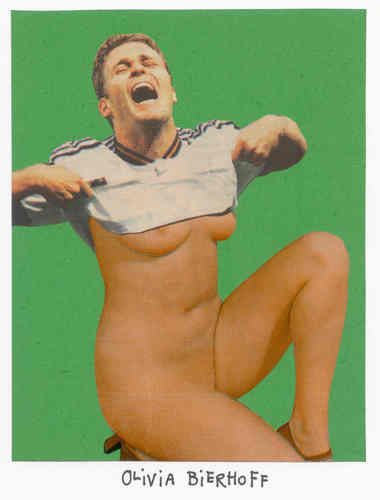 My favorite cartoon this week is a collage by Berlin-based Andreas Prüstel. “Olivia Bierhoff” shows a gender-ambiguous Bierhoff in the midst of exposing his body to the crowd. I love how Andreas saw the parallels between the standard pin-up pose and freeze-frame of the football player performing equally standardized moves of celebration and combined them in a slightly yellowed collage that could be from a 70s girlie magazine. The shirt-off mode of cheering will always be puzzling to me. Is it a substitute for dropping one’s pants? A displacement activity? Fan service? The cartoon seems to argue for the latter.
My favorite cartoon this week is a collage by Berlin-based Andreas Prüstel. “Olivia Bierhoff” shows a gender-ambiguous Bierhoff in the midst of exposing his body to the crowd. I love how Andreas saw the parallels between the standard pin-up pose and freeze-frame of the football player performing equally standardized moves of celebration and combined them in a slightly yellowed collage that could be from a 70s girlie magazine. The shirt-off mode of cheering will always be puzzling to me. Is it a substitute for dropping one’s pants? A displacement activity? Fan service? The cartoon seems to argue for the latter.
Paul Hellmich
]]>A jury comprised of four toonpool.com staff members and three external jurors decided on the winners of the “alternative” Elections 2009 Cartoon Contest. It took some time, but after more than 300 cartoons and caricatures and some disagreement, we decided on three winners. Click here for further information.
Apart from that, the 50.000th cartoon was uploaded to our server on Tuesday. Congratulations to user Katelein from Germany – by the way, this was the first cartoon she has posted.
Introducing…
I would like to introduce new member Engin Selcuk from Turkey (who unfortunately hasn’t uploaded an avatar yet). Most of Engin’s works are one panel cartoons like this one on Don Quixote or this one on massive libraries. Some others are sequential like this classic desert island cartoon or this bitter one on the future of war and I think both, sequential and one-panel cartoons work out well. A lot of Engin’s engins cartoons deal with the military and war and, like the one mentioned above, they are all pretty dark.
![]() Another interesting new artist is Miroslaw Hajnos from Poland. His pictures are handcrafted cartoon paintings without any dialogue or caption. I liked the classic hankerchief-hatted fiat polska (do people wear these things outside of cartoons?) and the soup of justice. Some of the cartoons, however, e.g. the bare-breasted, tied-up woman on a gas burner made me feel uncomfortable.
Another interesting new artist is Miroslaw Hajnos from Poland. His pictures are handcrafted cartoon paintings without any dialogue or caption. I liked the classic hankerchief-hatted fiat polska (do people wear these things outside of cartoons?) and the soup of justice. Some of the cartoons, however, e.g. the bare-breasted, tied-up woman on a gas burner made me feel uncomfortable.
Cartoons of Interest
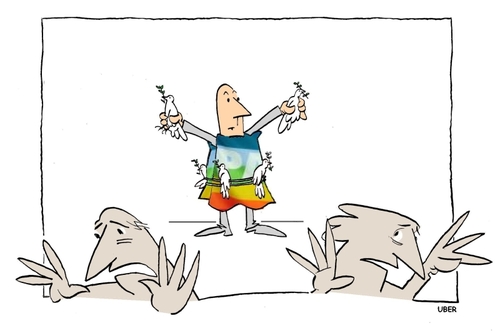 My favorite cartoon this week is “Pax Bum” by Uber. On a superficial level you could say it’s about people being afraid of peace. But just imagine these doves really could explode in a puff of feathers and particles of olive branches. That’s what makes the cartoon dear to me … it could be the first minutes of a surreal massacre without any clear-cut meaning and still be funny in an uncomfortable way. Oh, and the composition of the cartoon is really great, too.
My favorite cartoon this week is “Pax Bum” by Uber. On a superficial level you could say it’s about people being afraid of peace. But just imagine these doves really could explode in a puff of feathers and particles of olive branches. That’s what makes the cartoon dear to me … it could be the first minutes of a surreal massacre without any clear-cut meaning and still be funny in an uncomfortable way. Oh, and the composition of the cartoon is really great, too.
I would also like to refer to this cartoon by Pohlenz. Using a range of colors similar of “Pax Bum”, it pretty much sums up my experience of the elections. All these ridiculous faces on the election posters made it so easy to take a cynical outsider’s position to a decision that actually is important. I’ll be glad when they are gone .
]]>Introducing…
 Of this week’s new members, I would like to introduce Zsolt Vidak from Budapest first. Some of Vidaks works are pages of comic books rather than cartoons, others are more on the illustration side – but they all share imaginative ideas and a very own style of art. I especially like the “used” feel of the images and the colors he uses: that dulled down turquoise, the eye-catching orange and the shades of beige. Be sure to check out the bonsai man and this one on capitalism.
Of this week’s new members, I would like to introduce Zsolt Vidak from Budapest first. Some of Vidaks works are pages of comic books rather than cartoons, others are more on the illustration side – but they all share imaginative ideas and a very own style of art. I especially like the “used” feel of the images and the colors he uses: that dulled down turquoise, the eye-catching orange and the shades of beige. Be sure to check out the bonsai man and this one on capitalism.
 The other new entry is Tallil Abdellatif, aka Caritas. Most of his works are monochromatic line drawings, sometimes adding a single field of color. Take a look at this take on Picasso’s Guernica, this one on aggressive use of ballots and my personal favorite: the double-bass. Caritas’ cartoons are at times controversial but seldom uninspired and cliché-laden. I could imagine interesting discussions developing out of them.
The other new entry is Tallil Abdellatif, aka Caritas. Most of his works are monochromatic line drawings, sometimes adding a single field of color. Take a look at this take on Picasso’s Guernica, this one on aggressive use of ballots and my personal favorite: the double-bass. Caritas’ cartoons are at times controversial but seldom uninspired and cliché-laden. I could imagine interesting discussions developing out of them.
Cartoons of Interest
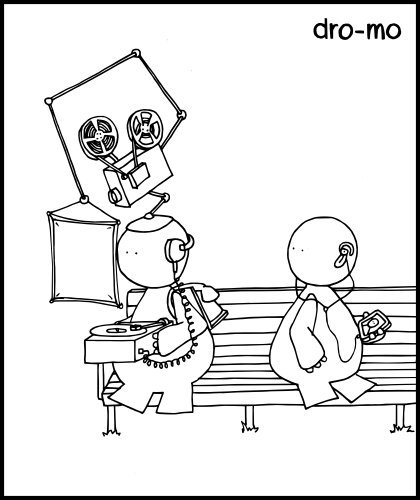 My favorite cartoon this week is by mysterious Miss or Mister Dro-Mo. It shows that you only need some determination to make analogue technology work in our oh-so-mobile world. And for someone who allegedly “can’t draw” (see Dro-Mos profile) this is a pretty decent projector & record player and a nice, clear line style, too. My other favorite was Mike Shiell’s cartoon about a professional clown, but in the end my love for all things lo-fi won.
My favorite cartoon this week is by mysterious Miss or Mister Dro-Mo. It shows that you only need some determination to make analogue technology work in our oh-so-mobile world. And for someone who allegedly “can’t draw” (see Dro-Mos profile) this is a pretty decent projector & record player and a nice, clear line style, too. My other favorite was Mike Shiell’s cartoon about a professional clown, but in the end my love for all things lo-fi won.
I would also like to refer to Ben Heine’s recent Obama drawings. We all knew this guy had a great technique, but artistry-wise this puts the whole thing up a few notches. Personally, I am most impressed by the one with all the lines and think that the two others are somewhat uncanny in their slickness. What does everybody else think?
Paul Hellmich
]]>Summer in Berlin seems to be almost over, the air feels like autumn. This is the first issue of our new weekly column, reporting on the last seven days on toonpool.com. This time it’s all about self-referentiality: First of all, the toonpool.com blog has been re-designed and renamed. The new design will make it easier to navigate the articles and quickly locate all reviews, interviews or articles on recent cartoon events. Most important news (for myself at least): I have joined toonpool.com and from now on will provide some interviews and articles, as well as this little column. So, if you have any comments or suggestions, feel free to leave a message.
Introducing…
This is where I would like to introduce two artists who have recently joined toonpool.com.
![]() The first one is Cuban-born Gustavo Rodriguez, aka Garrincha. So far, he has uploaded two distinct and equally great types of work: There are his one-panel gag cartoons – beautifully crafted line drawings with a very effective use of digital water-color. All of them are slightly surreal and sometimes a bit on the naughty side. Take this one on bankers, or this one on rich people looking for love. The other type of work are his vector-style caricatures. including a brightly colored Elton John and a bug-eyed Jaco Pastorius.
The first one is Cuban-born Gustavo Rodriguez, aka Garrincha. So far, he has uploaded two distinct and equally great types of work: There are his one-panel gag cartoons – beautifully crafted line drawings with a very effective use of digital water-color. All of them are slightly surreal and sometimes a bit on the naughty side. Take this one on bankers, or this one on rich people looking for love. The other type of work are his vector-style caricatures. including a brightly colored Elton John and a bug-eyed Jaco Pastorius.
 Artist Daulle from France has uploaded only three caricatures. And I don’t really like the Sarkozy one. But the two others are just great: There is Libya’s Colonel Gaddafi drawn from an unusual angle using expressive, almost chaotic strokes that recreate his air of grandiose dictatorial shaggy-ness. And there is cartoon legend Sergio Aragonés , again drawn with these expressive strokes, but more disciplined this time. Hopefully, there will be more from Daulle in the weeks to come.
Artist Daulle from France has uploaded only three caricatures. And I don’t really like the Sarkozy one. But the two others are just great: There is Libya’s Colonel Gaddafi drawn from an unusual angle using expressive, almost chaotic strokes that recreate his air of grandiose dictatorial shaggy-ness. And there is cartoon legend Sergio Aragonés , again drawn with these expressive strokes, but more disciplined this time. Hopefully, there will be more from Daulle in the weeks to come.
Cartoons of Interest
My favorite cartoon this week is “Bomb” by Joruju Piroshiki. I’ve been a fan of Joruju’s simplistic style since he came to toonpool.com and this cartoon only proves that he is a great cartoonist with unusual ideas. Such a weird and quiet little scene among the roar of the explosions.
Apart from that, I’d like to point out Michele Rochetta’s interesting project “Hollywood Bestiary” – a kind of vectorized compendium of celebrity/animal hybrids. An interesting idea and formidably executed too.
Paul Hellmich
